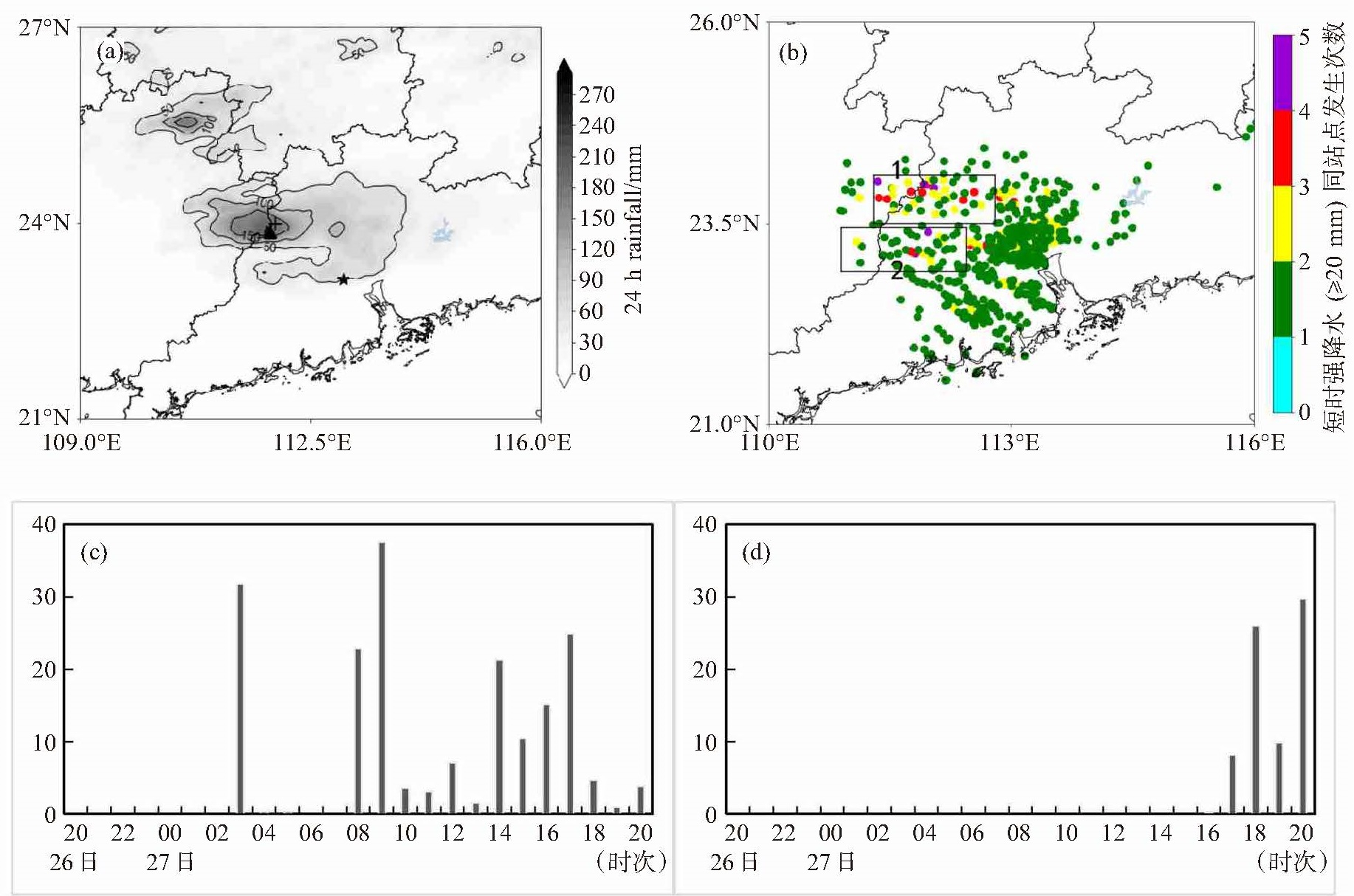Analysis of Causation and the Meso-scale Convective Systems in a Strong Heavy Rainfall in Warm Sector Ahead of Fronts in South China
-
摘要: 2020年3月27日华南地区发生一次典型的锋前暖区暴雨过程,过程持续超过15 h,出现中尺度对流系统MCS-A、MCS-B与MCS-C并产生多次分裂与重组。利用地面自动站数据、多普勒天气雷达资料、ECMWF-ERA5地面和高空再分析场资料,结合中尺度CMA-GD模式对此次暖区暴雨过程环流形势与中尺度对流系统组织特征和触发条件等方面进行分析。结果表明:(1)高低空环流包括500 hPa高空槽、200 hPa西风急流与锋前低槽等系统的有利配置且稳定少动是暖区暴雨长时间维持的重要原因。持续维持的低空急流为对流发生发展提供了有利的条件性不稳定和对流有效位能。(2)伴随自由对流高度降低与CIN抑制能量减小,贺州至怀集一带的关键区域1处对流在地面得以触发,而距离1处南向约80 km的关键区域2中1 500 m高度处风速辐合与冷池作用使得对流发生。(3)MCS-A与MCS-B在关键区域1处触发,呈现前向与后向传播,MCS-C在关键区域2处触发后以后向传播为主。此外,MCS-B与MCS-C表现为多条平行排列的南北向短雨带并产生向东移动的“列车带效应”,而MCS-A与MCS-B则表现为多次分裂与重组后形成向东南移动的“列车带效应”。(4)中β尺度次级环流的上升支抬升西南暖湿气流,使其倾斜上升凝结潜热释放,造成后向传播对流系统的发生发展。同时由于强降水拖曳作用,850 hPa以下转下沉气流造成一定厚度的冷池后与暖湿入流叠加,触发新对流单体,也影响后向传播。(5)上游MCSs发生后在地面形成冷池出流,与暖湿气流辐合抬升,造成前端对流触发。Abstract: The evolution of three mesoscale convective systems (MCS), i. e., MCS-A, MCS-B, MCS-C, experienced multiple division and reorganization, resulting in a heavy rainfall in the warm sector ahead of fronts in Southern China on 27 March 2020, which sustained for more than 15 hours. The synoptic background, organization modes and initiation conditions of MCS are analyzed by using surface automatic meteorological stations data, Doppler weather radar data, ERA-Interim reanalysis data and mesoscale CMAGD model data. The results are shown as follows. (1) Favorable configuration and stable circulation systems, including a 500 hPa upper-level trough, a 200 hPa westerly jet and a frontal trough are important reasons for long-term maintenance of the warm-sector heavy rainfall. The low-level jet provides conditional instability and convective available potential energy for the generation and development of convection. (2) The convection in key region 1 from Hezhou to Huaiji was triggered on the ground with the decrease of the level of free convection and the reduction of CIN energy. The interaction between wind speed convergence at the height of 1500 m and a cool pool in key region 2 80 km away from key region 1 resulted in the convection. (3) MCS-A and MCS-B are modulated into forward and backward propagation in key region 1, while MCS-C is modulated into backward propagation in key region 2. The convective cells of all three MCSs form echo"train band effects". In addition, both MCS-B and MCS-C form several short and parallel convective rainbands in a nearly N-S direction triggering eastward"train band effects". MCS-A and MCS-B split again into short and parallel convective rainbands in a nearly NE-SW direction triggering southeastward"train band effects". (4) The warm and humid southwesterly flow on the left side of the meso - β - scale secondary circulation is lifted, releasing latent heat and triggering convection. The interaction of the cold outflow resulting from the drag effect of heavy precipitation formed a downdraft below 850 hPa and a warm inflow on the west side near the surface was conductive to new convection, which was the development mechanism of the backward propagation. (5) Forward propagation was caused by the convergence between the cold pool outflow, which was formed on the ground after the genesis of upstream MCSs, and the warm moist flow.
-
-
[1] 丁一汇. 中国暴雨理论的发展历程与重要进展[J]. 暴雨灾害, 2019, 38(5): 395-406. [2] 陶诗言. 中国之暴雨[M]. 北京: 科学出版社, 1980: 225. [3] 包澄澜, 王两铭, 李真光. 华南前汛期暴雨的研究[J]. 气象, 1979(10): 8-10. [4] 中国气象科学研究院. 98年华南暴雨科学试验研究[J]. 北京: 中国气象科学研究院, 2007-01-01. [5] 陈红, 赵思雄. 海峡两岸及邻近地区暴雨试验(HUAMEX)期间暴雨过程及环流特征研究[J]. 大气科学, 2004(1): 32-47. [6] LUO Y L, ZHANG R H, WAN Q L, et al. The southern China monsoon rainfall experiment(SCMREX)[J]. Bull Amer Meteor Soc, 2017, 98 (5): 999-1 013. [7] 陈翔翔, 丁治英, 刘彩虹, 等. 2000—2009年5、6月华南暖区暴雨形成系统统计分析[J]. 热带气象学报, 2012, 28(5): 707-718. [8] 梁巧倩, 项颂翔, 林良根, 等. 华南前汛期MCS的活动特征及组织发展形式[J]. 热带气象学报, 2012, 28(4): 541-551. [9] 刘瑞鑫, 孙建华, 陈鲍发. 华南暖区暴雨事件的筛选与分类研究[J]. 大气科学, 2019, 43(1): 119-130. [10] 孙建华, 赵思雄. 华南"94·6"特大暴雨的中尺度对流系统及其环境场研究Ⅰ. 引发暴雨的β中尺度对流系统的数值模拟研究[J]. 大气科学, 2002, 26(4): 541-557. [11] 蒙伟光, 张艳霞, 戴光丰, 等. 华南沿海一次暴雨中尺度对流系统的形成和发展过程[J]. 热带气象学报, 2007, 32(6): 521-530. [12] 罗建英, 廖胜石, 黄归兰, 等. 广西前汛期锋前暖区暴雨过程的模拟与分析[J]. 气象, 2009, 35(10): 50-57. [13] 苗春生, 杨艺亚, 王坚红, 等. 两类华南沿海暖区暴雨特征及热力发展机制对比研究[J]. 热带气象学报, 2017, 33(1): 53-63. [14] 胡宁, 汪会. 华南一次强对流天气过程中环境条件对MCS形态特征的影响[J]. 热带气象学报, 2019, 35(5): 681-693. [15] 陈涛, 张芳华, 符娇兰, 等. 2014年5月8—9日引发珠江口区域强降水的两个长生命史MCS特征分析[J]. 气象, 2020, 46(4): 449-461. [16] 黄土松. 华南前汛期暴雨[M]. 广州: 广东科技出版社, 1986: 244. [17] 黄土松, 李真光, 包澄澜, 等. 华南前汛期暴雨[M]. 广州: 广东科技出版社, 1986: 55-100. [18] ZHANG M R, MENG Z Y. Warm-sector heavy rainfall in southern China and its WRF simulation evaluation: a low-level-jet perspective[J]. Mon Wea Rev, 2019, 147(12): 4 461-4 480. [19] 赵玉春, 李泽椿, 肖子牛. 华南锋面与暖区暴雨个例对比分析[J]. 气象科技, 2008(1): 47-54. [20] 夏茹娣, 赵思雄. 2005年6月广东锋前暖区暴雨β中尺度系统特征的诊断与模拟研究[J]. 大气科学, 2009, 33(3): 468-488. [21] 陶祖钰. 湿急流的结构及形成过程[J]. 气象学报, 1980, 38(4): 331-340. [22] DU Y, CHEN G X. Heavy rainfall associated with double low-level jets over southern China. Part Ⅱ: Convection initiation[J]. Mon Wea Rev, 2019, 147(2): 543-565. [23] 孙健, 赵平, 周秀骥. 一次华南暴雨的中尺度结构及复杂地形的影响[J]. 气象学报, 2002, 60(3): 333-342. [24] 徐珺, 毕宝贵, 谌芸, 等. "5.7"广州局地突发特大暴雨中尺度特征及成因分析[J]. 气象学报, 2018, 76(4): 511-524. [25] 常越. 南方暴雨的气候特征以及触发、维持机制[D]. 南京: 南京信息工程大学, 2008. [26] 裴昌春, 赵宇, 程思. 福建沿岸一次飑线过程发生发展机理分析[J]. 气象科技, 2019, 47(5): 841-850. [27] 王莹, 苗峻峰, 苏涛. 海南岛地形对局地海风降水强度和分布影响的数值模拟[J]. 高原气象, 2018, 37(1): 207-222. [28] 何立富, 陈涛, 孔期. 华南暖区暴雨研究进展[J]. 应用气象学报, 2016, 27(5): 559-569. [29] 俞小鼎, 周小刚, 王秀明. 雷暴与强对流临近天气预报技术进展[J]. 气象学报, 2012, 70(3): 311-337. [30] WANG H, LUO Y, JOU B J. Initiation, maintenance, and properties of convection in an extreme rainfall event during SCMREX: Observational analysis[J]. J Geophy Res, 2015, 119(23): 13 206-13 232. [31] 田付友, 郑永光, 张小玲, 等. 2017年5月7日广州极端强降水对流系统结构、触发和维持机制[J]. 气象, 2018, 44(4): 469-484. [32] 柯文华, 俞小鼎, 林伟旺, 等. 一次由"列车效应"造成的致洪暴雨分析研究[J]. 气象, 2012, 38(5): 552-560. [33] 李明华, 陈芳丽, 姜帅, 等. "18.8"粤东暴雨中心极端强降水"列车效应"分析[J]. 暴雨灾害, 2019, 38(4): 329-337. [34] LUO Y L, GONG Y, ZHANG D L. Initiation and organizational modes of an extreme-rain-producing mesoscale convective system along a Mei-Yu front in East China[J]. Mon Wea Rev, 2014, 142(1): 203-221. [35] SCHUMACHER R S, JOHNSON R H. Organizational modes of midlatitude mesoscale convective system[J]. Mon Wea Rev, 2000, 128 (10): 3 413-3 436. [36] 孙继松, 何娜, 郭锐, 等. 多单体雷暴的形变与列车效应传播机制[J]. 大气科学, 2013, 37(1): 137-148. -






 下载:
下载:













 粤公网安备 4401069904700003号
粤公网安备 4401069904700003号